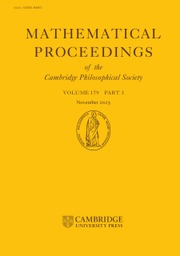No CrossRef data available.
Article contents
On absolute continuity and maximal Garsia entropy for self-similar measures with algebraic contraction ratio
Published online by Cambridge University Press: 24 September 2025
Abstract
We consider the self-similar measure  $\nu_\lambda=\text{law}\left(\sum_{j \geq 0} \xi_j \lambda^j\right)$ on
$\nu_\lambda=\text{law}\left(\sum_{j \geq 0} \xi_j \lambda^j\right)$ on  $\mathbb{R}$, where
$\mathbb{R}$, where  $|\lambda| \lt 1$ and the
$|\lambda| \lt 1$ and the  $\xi_j \sim \nu$ are independent, identically distributed with respect to a measure
$\xi_j \sim \nu$ are independent, identically distributed with respect to a measure  $\nu$ finitely supported on
$\nu$ finitely supported on  $\mathbb{Z}$. One example of such a measure is a Bernoulli convolution. It is known that for certain combinations of algebraic
$\mathbb{Z}$. One example of such a measure is a Bernoulli convolution. It is known that for certain combinations of algebraic  $\lambda$ and
$\lambda$ and  $\nu$ uniform on an interval,
$\nu$ uniform on an interval,  $\nu_\lambda$ is absolutely continuous and its Fourier transform has power decay; in the proof, it is exploited that for these combinations, a quantity called the Garsia entropy
$\nu_\lambda$ is absolutely continuous and its Fourier transform has power decay; in the proof, it is exploited that for these combinations, a quantity called the Garsia entropy  $h_{\lambda}(\nu)$ is maximal.
$h_{\lambda}(\nu)$ is maximal.
In this paper, we show that the phenomenon of  $h_{\lambda}(\nu)$ being maximal is equivalent to absolute continuity of a self-affine measure
$h_{\lambda}(\nu)$ being maximal is equivalent to absolute continuity of a self-affine measure  $\mu_\lambda$, which is naturally associated to
$\mu_\lambda$, which is naturally associated to  $\lambda$ and projects onto
$\lambda$ and projects onto  $\nu_\lambda$. We also classify all combinations for which this phenomenon occurs: we find that if an algebraic
$\nu_\lambda$. We also classify all combinations for which this phenomenon occurs: we find that if an algebraic  $\lambda$ without a Galois conjugate of modulus exactly one has a
$\lambda$ without a Galois conjugate of modulus exactly one has a  $\nu$ such that
$\nu$ such that  $h_{\lambda}(\nu)$ is maximal, then all Galois conjugates of
$h_{\lambda}(\nu)$ is maximal, then all Galois conjugates of  $\lambda$ must be smaller in modulus than one and
$\lambda$ must be smaller in modulus than one and  $\nu$ must satisfy a certain finite set of linear equations in terms of
$\nu$ must satisfy a certain finite set of linear equations in terms of  $\lambda$. Lastly, we show that in this case, the measure
$\lambda$. Lastly, we show that in this case, the measure  $\mu_\lambda$ is not only absolutely continuous but also has power Fourier decay, which implies the same for
$\mu_\lambda$ is not only absolutely continuous but also has power Fourier decay, which implies the same for  $\nu_\lambda$.
$\nu_\lambda$.
Information
- Type
- Research Article
- Information
- Copyright
- © The Author(s), 2025. Published by Cambridge University Press on behalf of Cambridge Philosophical Society

